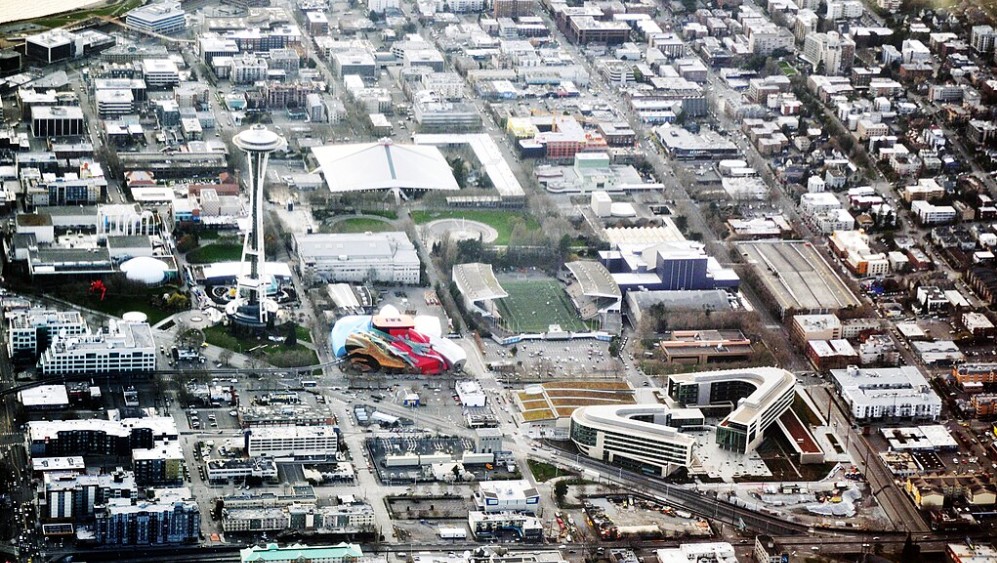One of the most promising appointments by the Mayor Harrell administration was the naming of Marshall Foster to be the new director (confirmed three weeks ago) of Seattle Center. Foster is “one of the most capable problem solvers in local government,” says City Councilman Andrew Lewis, who has oversight for Seattle Center.

Added to the Foster portfolio is direction of Waterfront Park, meaning control over programs, security, and maintenance. That expansion of the Center is another smart move. Mayor Harrell and Deputy Mayor Tim Burgess (to whom Foster now reports) were closely involved in the execution. Outgoing Seattle Center Director Robert Nellams, who retired recently after 17 years as a popular director, also helped guide this transition. Waterfront Park, now nearing completion, resembles Seattle Center in public programming, security needs, and upkeep.
Foster has a solid reputation at city hall, where he has been a planning director and the city’s main man for major projects, such as Waterfront Park and Climate Pledge Arena. He knows how to forge partnerships and move complicated projects over the finish line. He also has experience in urban design and is an urban planner by profession.
Foster understands that Seattle Center’s main need is “financial stability.” Two-thirds of the $58 million annual budget is earned by rentals and tickets, and the rest comes from the general fund at city hall, where much more pressing needs (homelessness, housing, police) have priority. Many of the buildings from the 1962 World’s Fair have very dated infrastructure, and the staff at the Center is adept at duct-tape solutions. Many of the rentals for arts groups and other pet projects of mayors and city councilmembers pay modest rents.
Before Nellams, the director was Virginia Anderson, appointed by Mayor Paul Schell, for whom she worked as a smart, tough developer. Anderson oversaw the arrival of Paul Allen’s Experience Music Project and the adjoining Gates Foundation. She also tried to get a ballot position for a special levy and drew up a (now outdated) strategic plan to make the case. But the levy never bumped aside more urgent levies for housing, libraries, parks. Foster seems ready to go down that path again and has started a new strategic plan.
That new vision makes sense, in part because many things have changed at the Center. One is the arrival of Climate Pledge Arena, a new bigfoot at the Center (the other being the Space Needle). Another is the decades-long resolution of Memorial Stadium, owned by the school district, a difficult civic dance partner. A third change is the forced exit of KCTS/Crosscut from its city-owned building in the northeast corner of the 74-acre Center. The fourth is the need for a new Sound Transit stop at the western edge of the Center, meaning more construction delays and scrapping over impacts.
It’s a massive menu of problems, for which Foster is quite experienced and deft at partnerships. Some of the buildings are overbuilt by optimism (the Children’s Theatre, KCTS, under-used Cornish Playhouse), and others have serious infrastructure problems such as the Science Center and its leaky reflection pools. Much of the Center has been privatized (Chihuly Garden and Glass, Climate Pledge Arena, Memorial Stadium), and others (Science Center, Space Needle) own their own parcels of land. Traffic access is another problem, particularly on nights when Climate Pledge Arena congests the streets and parking.
That said, the Center has some inherent advantages. One is its comprehensive management entity, combined as a department. Another is the affection citizens have for the popular Center; Foster says Seattle Center ranks just after the Pike Place Market in local pride, much helped by the revival this past year of the Bumbershoot arts and music festival.
In a city increasingly unsafe (or thought to be), Seattle Center has (as does the Market) a skilled private security force. The Seattle Center Foundation opens doors to private philanthropy, which will be key to a bond issue or a levy campaign. The addition of Waterfront Park gives the Center more performance stages and access to private donations.
The biggest problem is that the city has come to regard the Center as an orphan. For some directors, that translates into keeping the lid on warfare among proud nonprofits with their own support bases. An unresolved conflict is whether the Center is primarily an arts-oriented Lincoln Center, a tourist attraction (particularly on the east edge), or a festival gathering place. The usual Seattle solution is to be all of the above — on a tight budget.
It all adds up to a need for a new and compelling image or vision for the ageing Center. Many think that Marshall Foster is just the person to orchestrate this new symphony, if he hasn’t arrived too late to find a new harmony.
Discover more from Post Alley
Subscribe to get the latest posts sent to your email.

I agree with your judgment about Marshall Foster. He successfully navigated many crises among competing interests in the design and development of Waterfront Park. Sounds like he is the right guy to help Seattle Center move forward for a new generation.
Worked with Marshall and gained much appreciation for his expertise. Seattle lucky to have him as a manager and visionary.
Marshall is the right person to lead Seattle Center in these times. His collected experience from serving in multiple civic roles has prepared him for addressing the many challenges and opportunities presented by our iconic but aging public amenity. He cares about design, knows how to assemble the appropriate resources required to solve complex urban problems and is masterful at the difficult task of consensus building.
Footnote, courtesy of Dean Nielsen:
“Mayor Schell and Virginia Anderson put a part of the comprehensive Seattle Center plan on the 1999 ballot; it paid for the remodeling of the Opera House and the building that was known at the time as the Flag Pavillion. I know because I managed the campaign and Blair Butterworth did the media.”